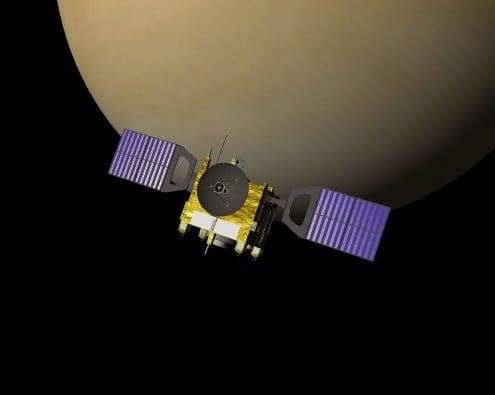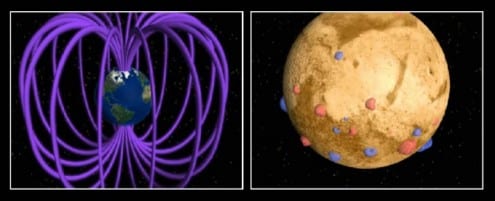Mars, Earth and Venus are very similar in many respects.
They are all rocky planets of roughly similar size; all three have atmospheres, weather and seasons, as well as extensive ranges of mountains and canyons on their surfaces.
But in other respects they are quite different.
Earth’s atmosphere is generally placid. But on Mars, it is so thin that liquid water cannot exist at any temperature, and on Venus, the atmospheric pressure is equivalent to diving almost 1000 metres into the ocean. On Mars, temperatures rarely venture above 0°C and can drop below -100°C; Venus meanwhile has surface temperatures of over 450°C, hot enough to melt lead.
The thin atmosphere of Mars is thought to be due to the planet’s lack of a magnetic field, which has allowed the Solar wind to blow away much of the gas the planet once had.
Venus, despite still having a thick atmosphere of CO2, surprisingly has a similar problem. Venus also lacks a magnetic field, and it is losing gas at a similar rate to the red planet.
The interaction of the Solar wind with the Venusian atmosphere has been studied by the Venus Express probe, which has been orbiting the planet since 2006.

Computer rendering of ESA’s Venus Express probe. Credit: public domain (Celestia)
Like many ESA space missions, UCL was intimately involved in the design and construction of the scientific apparatus on board. In the case of Venus Express, this involved a leading role in the development of the electron spectrometer on board, as well as building the shielding and carrying out the calibration for the detector.
This detector has been able to measure the varying rate at which the atmosphere is being lost.
Venus Express is currently entering the final stages of its mission. The spacecraft is being brought progressively closer to the planet’s surface, skimming through the upper atmosphere. The friction of the tenuous gas is enough to heat the probe up, and to further slow it down, bringing it closer still. This process of aerobraking will eventually destroy Venus Express, but in the process, its instruments will be able to gather valuable scientific data about the planet’s upper atmosphere, including – thanks to the electron spectrometer – its electrical properties.
Postscript
No NASA or ESA probe has ever reached the surface of Venus. But a series of bold Soviet missions in the 1960s, 70s and 80s made several landings on the surface, as well as a balloon that floated through the planet’s atmosphere. The Venera probes revealed a rock-strewn landscape in the few minutes they were able to survive before being destroyed by the high temperatures and pressures there. More information on the Venera 13 and Venera 14 pictures held by UCL’s planetary science archives can be found on the archives’ space history webpages.

Photograph of the surface of Venus from Venera 13. Photo: public domain (UCL/NASA Regional Planetary Image Facility)
![]() Written by Professor Andrew Coates, UCL Mullard Space Science Laboratory
Written by Professor Andrew Coates, UCL Mullard Space Science Laboratory
 Close
Close


 Apollo 11, which touched down in the Sea of Tranquility on 20 July 1969 was the first manned landing on the Moon. But prior to the human spaceflight project, NASA explored the Moon with robotic probes. One key element of this endeavour was the Lunar Orbiter programme, which included five spacecraft that mapped almost the entire lunar surface in 1966 and 1967. This was in part in order to identify landing sites for Apollo, but the missions also had broader scientific goals.
Apollo 11, which touched down in the Sea of Tranquility on 20 July 1969 was the first manned landing on the Moon. But prior to the human spaceflight project, NASA explored the Moon with robotic probes. One key element of this endeavour was the Lunar Orbiter programme, which included five spacecraft that mapped almost the entire lunar surface in 1966 and 1967. This was in part in order to identify landing sites for Apollo, but the missions also had broader scientific goals.




